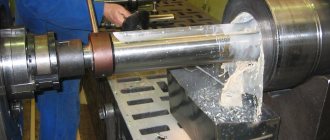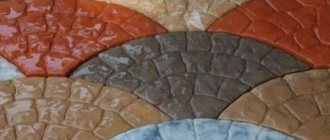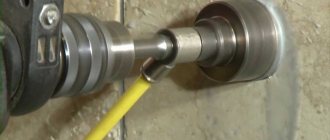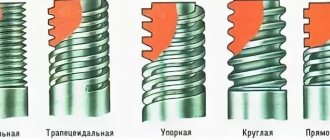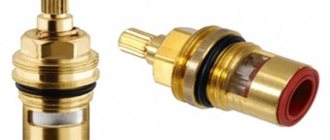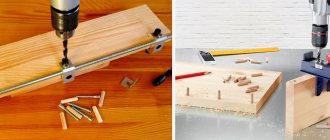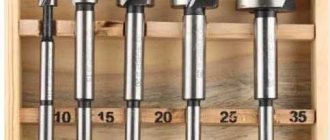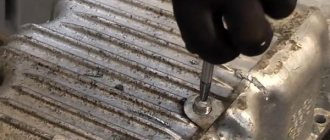When renovations in an apartment are nearing completion, it’s nice to look at the work done. New tiles in the bathroom or kitchen sparkle on the walls, but often there is a need to make a hole in the tile to hang a mirror or towel rack or other accessories.
Drilling ceramic tiles in the bathroom
Not everyone knows how and with what to drill ceramic tiles so as not to damage their integrity. It is extremely easy to spoil fragile ceramics; to avoid this, you need to know how to work with it.
Basic principles of drilling ceramic tiles
When working with ceramic tiles, it is very important to take into account its parameters (thickness, length). The drilling process must be treated with extreme care and precision. Important factors to take into account include:
- overheating of the tile and drill is not allowed, as this may cause the ceramic to split;
- it is necessary to cool the working surface by regularly spraying with water;
- the pressure on the mechanism should be chosen optimally, not too strong, but not too low. In the first case, the tile will probably break, in the other, it will not be possible to drill a hole;
- When drilling holes in tiles, reverse mode is unacceptable. The rotation of the drill should be leisurely and strictly in a clockwise direction;
- If a hole is made in a seam, care must be taken. There is no protective layer at the edge of the ceramic tile, so the center of the hole must be located strictly in the middle of the seam.
It is important to drill the tiles correctly so that they do not crack.
How to make a hole
Depending on the required diameter of the hole for a pipe, sink, or just a dowel, one or another drilling option is selected. Some of them can only be used if it is necessary to obtain a hole for a nail.
Options
The principles of cutting tiles are similar in all cases, but has its own characteristics depending on the chosen tool. The main thing is compliance with safety precautions.
Drill for ceramics
Let's look at the drilling options:
- Gradual increase in drill diameter. The advantage is that the risk of chipping is minimal. Stages:
- We take the smallest drill diameter.
- Drill slowly, avoiding overheating of the drill. To do this, moisten it with water.
- After digging into the surface, when the tool does not slide so much, also spray the tile with water.
- After obtaining the first hole, take a drill of a different, larger diameter.
- When there is only a thin drill. Stages:
- Drill several holes along the contour of the future hole for the pipe.
- Next, without making much effort, knock out the center.
- Sand any existing irregularities using sandpaper.
To begin with, take coarse sandpaper and gradually reduce the grain size. This will ensure the smoothest inner surface possible.
Carbide drill for concrete
A carbide drill is also used for drilling tiles. Sold in construction stores as a drill with a pobedit tip. When working with it, you should adhere to the following rules:
- Drill at low speed.
- The use of a striking mechanism is not permitted.
- The pressure on the drill during operation is minimal.
- Turn on the impact mechanism only after obtaining a through hole in the tile, when the drill touches the concrete. At this time, you can increase the speed of the drill.
Diamond-coated crown
The diameter must be selected according to the size of the future hole. Drilling order:
- Masking tape should be applied to the tiles.
- Make markings.
- Start working with the drill at low speed. To prevent overheating, the crown should be moistened with water.
Circular tile drill/ballerina drill
There are special attachments on the market for making holes in tiles - ballerinas. Essentially, this is a drill with an additional cutting element.
Stages:
- Make a recess in the center of the future hole using any method.
- Secure the center drill into the hole you made.
- Work with the drill at low speeds at first. Gradually going deeper, the side nozzles will begin to scratch the tiles.
- When half the work is done, you should turn the tile over and perform the same steps until the center falls out.
Using self-tapping screws with a LM tip
In cases where a hole needs to be made urgently, and there is no drill with attachments or drill bits at hand, use self-tapping screws with a LM tip. Operating procedure:
- Outline the diameter.
- We screw in screws along the inner contour at small intervals and unscrew them.
- We squeeze out the center and smooth out the irregularities with sandpaper.
Bulgarian
To make through holes in the tiles before installing them or cutting them into shapes, a grinder is most often used. How to use the tool:
- Outline the contours.
- Install a diamond dry cutting blade.
- Make a hole gradually. The tool should be smoothly moved away from you. Take care of your fingers. Hold the tile to prevent it from slipping.
The work is carried out on the front side of the tile to avoid chipping.
Jigsaw
Used to make holes of various shapes at the edge of the tile or in its center.
Stages:
- Marking. Produced from the front side.
- Need to cut from the edge of a tile? You can start working.
- Need to make a hole in the center? A small hole is made with a drill to fit the cutting area of the jigsaw through.
- Place the tool on the border of the cutout.
- Slowly, we move the jigsaw along the markings.
It is recommended to make a small indent from the marked line deep into the tile so as not to catch the excess area.
Under the pipe
All options considered are suitable for making a hole. An exception is the method of drilling through ceramics with a gradual increase in diameter, since there is no tool of this size.
For the great snipe
You can make a hole for the dowel using almost any method considered. However, options such as using a jigsaw and ballerina are considered inappropriate in this case. It is best to use a ceramic or tile drill.
How to cut for a faucet
The size of the hole for the mixer is smaller in diameter than for the pipe. However, the drilling options are identical in both cases.
Under the socket
Sockets come in different shapes. Therefore, when choosing a tool, you should build on it. If the shape is round, then all options are suitable except for gradually increasing the size of the drill for ceramics. If it's square, the best solution is a jigsaw.
Choosing a tool
Ceramic tile coating has been described as a reliable and moisture-resistant material. It is used for walls and floors in the bathroom and kitchen. The tiles perfectly protect walls from moisture.
An example of finishing a bathroom with ceramic tiles
Thanks to the color palette, it is easy to choose tiles to suit any apartment design.
Bathroom decoration with beige ceramic tiles
Since the hardness of ceramic tiles varies, drilling can be done with different tools:
- a hammer drill with a “no impact” drilling mode;
- hand drill;
- electric drill;
- corded or cordless screwdriver.
A hammer drill is used very often in repairs. Its main purpose is to drill holes in a variety of materials.
Hammer
Hammer diagram
Before you start drilling ceramic tiles, you need to determine the work procedure.
- Usually, on the front side of the tool there is a mark with a picture of a drill. It is necessary to turn the toggle switch to this position.
- When performing work, it is forbidden to press the hammer drill trigger with force. There should be no extraneous hum, shaking, or knocking.
hammer drill
How to insert a drill into a hammer drill
A hand drill is a mechanism of the simplest design, consisting of a frame and a chuck. To make holes in the tile, a drill is inserted into the chuck, and the device begins to work. It operates slowly, and you need to strain to make a hole. The advantage of the device is its independence from electricity. A hand drill is most often used to make small holes.
Hand drill (brace)
Electric drill - cope with the task in a few seconds. Operates from a 220 W network. The tool drills holes in ceramic tiles at low speeds using a light feed. The work area should be periodically cooled with water.
Electric drill
How to choose a drill
Screwdriver - There are two types. In order to make holes in the tiles, it is necessary to use a screwdriver (preferably cordless) at a speed not exceeding 900 rpm. A mains-powered device must also have a low-speed operating mode.
Screwdriver
screwdriver
What to consider when drilling into ceramics
If you need to carry out drilling work on tiles, you should choose the right model of electric drill. Suitable models are those that can operate at low speeds and in which the impact drilling mode is absent or can be turned off. Thus, in order to drill a hole in ceramic tiles with high quality, the following devices are optimally suited:
- electric drills that can operate at a minimum rotation speed of the cutting tool;
- cordless screwdrivers, the maximum rotation speed of which does not exceed 800–1000 rpm;
- low-speed screwdrivers operating from the central electrical network.
Main types of tile drills
A drill for tiles or ceramic tiles differs in its design from a tool used for drilling any other material. Processing of tiles using a special drill is carried out due to the friction forces created by the abrasive material applied to the working surface of the tool. The working part of a drill for ceramics or any other similar materials can have an arrow-shaped or crown-shaped configuration. In such situations, a tool with an adjustable processing diameter, which is commonly called a ballerina, is also often used.
When performing drilling work on ceramic tiles, it is important to adhere to certain rules that will allow you to obtain a high-quality result:
- It is necessary to constantly monitor the temperature of the drill and the ceramic tile being processed, since overheating can lead to failure of the tool and the appearance of cracks on the surface of the product. To prevent overheating, the processing area and drill must be periodically watered.
- The pressure exerted on the drill when working on ceramics should not be too weak (in which case it will not be possible to drill through the tiles) and too strong (this may lead to breakage of the workpiece).
- The drill should rotate slowly and only clockwise; reverse mode cannot be used, as this can lead to cracking of the tiles.
- In the event that it is necessary to drill not in the tile itself, but in the gap between two adjacent products, the drill should be placed strictly in the middle of the seam between the tiles. You should drill holes very carefully if they are located in close proximity to such a seam. In this case, the drill can easily slip into the seam, and it will not be possible to get a hole in the required place. It should also be taken into account that at the edges of the tile the thickness of the protective layer applied to it is minimal (or there is none at all), so when drilling in such places, pieces of material may break off from the tile.
Painting tape applied before marking will help make the hole neater
Very often you can find advice on preliminary punching the surface of the tile in the place where it is necessary to drill a hole. The design of modern drills used for tile work is designed in such a way that there is no need to perform this procedure, which can easily lead to breakage of the product.
One of the main rules: no matter what drill you use, it should always be sharp.
Drilling large diameter holes
When drilling holes for water pipes, a socket or a switch, where the diameter is more than 20 mm, use a ballerina or crowns.
Examples of unsuccessful drilling of tiles for electrical outlets
A crown is a tubular type instrument with a special (diamond) coating. The fairly high price of the cutter is offset by time savings and drilling quality. Using diamond core bits, it is possible to make holes with a diameter of up to 160 mm.
Drilling with cooling
Ballerina is a drill with a sharp tip, similar to a spear, on the lower part of which a holder is attached. Another drill of the same type is attached to it. By moving the bracket, you can set the diameter of the intended hole.
Drilling with a crown
Securing the crown
The drilling technique is similar to drilling for a dowel. The cutter is placed exactly parallel to the tile, so that when it goes deeper, the drill begins to evenly cut the ceramic around the circumference. Sideways movements are not allowed.
Drilling porcelain stoneware
Drilling with a diamond core involves the process of operating the drill at high speeds. Overheating in this case cannot be avoided; in order to avoid heating and burning of the crown, it is necessary to moisten the device with water. Of course, you can drill ceramics “dry”, but only at low speed.
If the cutter does not have diamond protection, do not use the “dry” method. Moreover, using water when drilling speeds up the process.
Drilling by ballerina
Working as a ballerina begins with setting the desired diametrical size. It is necessary to hold the tile and start drilling strictly at low speed. When working, it is recommended to use safety glasses to prevent waste particles from getting into your eyes.
Drilling with a circular ballerina drill
The drill must be held accurately, without changing position or tilting. Don’t forget to place a container of water nearby; when drilling ceramics with a ballerina, you also need it. The main thing is not to rush, act with caution so as not to damage the tiles.
The hole in the tile is cut by a ballerina
Advice! Drilling large diameters in tiles requires some skill. Therefore, it would be a good idea to practice on old tile scraps. Such training will allow you to “get your teeth into” and gain some experience, albeit a little!
Drill selection
When choosing equipment, you should pay special attention to what drill you use to drill ceramic tiles. If you choose the wrong tool, you will only be able to use it a few times, after which you can throw it away, as it will become completely unusable. To drill into tiles without such negative consequences, you need to choose the right drill.
Spear-shaped
You can drill a high-quality hole in ceramic tiles using a spear-type drill, which has a long service life. If you are thinking about how to drill a tile for a dowel, choose a tool of this type. It is also important that spear drills are affordable.
When drilling tiles with a spear drill, use a household vacuum cleaner to remove dust
Carbide with one-sided sharpening
How to drill tiles to get a high-quality result? For this purpose, a drill with a carbide plate sharpened on one side is often used. Sharpening the cutting part at an acute angle not only reduces the risk of overheating the drill, but also allows it to more easily drill through tiles, which are highly durable and brittle.
Crown type with diamond coating
Quite often it is necessary to drill the tiles in order to obtain a large diameter hole in it, intended for the installation of pipes and electrical outlets. Such a hole in the tile can have a diameter from 10 to 70 mm. In this case, it is best to use core drills, the working part of which is coated with diamond sputtering. A tool with a centering drill can be used in conjunction with a hand-held electric drill, and without it - only using stationary drilling equipment.
Diamond core bits are often sold in sets with one support plate for several bits
When drilling ceramic tiles with a diamond core bit, keep in mind that this tool is quite sensitive to overheating, so it must be cooled with water during the processing process.
Diamond-coated core drills are used at 200–500 rpm, and they must be properly cooled with water. The resource of such a tool, if you follow all the rules for its use, is enough for 20–50 drilled holes, which is a fairly good indicator.
By the way, diamond bits also come in small diameters.
The bits are coated with tungsten carbide.
How to drill through ceramic tiles without defects? This type of core drill allows you to easily solve this problem. They can also be used to process porcelain stoneware, marble and brick. The most significant disadvantage of such a tool is its high cost, but given its versatility and high efficiency, this price is quite justified.
A set of tungsten bits for tiles and tiles
With adjustable cutters (ballerina)
When deciding how to drill tiles in the bathroom in order to obtain a large-diameter hole, many home craftsmen choose the so-called ballerina. This drill can be used to drill holes with a diameter in the range of 30–90 mm.
The ballerina includes a central drill and a bracket along which clamps with cutters move. With the help of the latter, a groove is cut on the surface of the workpiece. A ballerina drill is most often used when it is necessary to drill a hole of non-standard diameter on the surface of a tile in a bathroom or toilet. If you decide to use a ballerina, keep in mind that the hole created with its help has uneven edges, which will later need to be covered with something.
Although “ballerina” does not provide ideal quality holes, it always helps out in the absence of crowns of the required diameter
How else can you drill into tiles?
There is another technique that can be used to make a large hole in a tile that is not yet glued to the wall. To do this, as mentioned earlier, the ceramics are immersed in a basin of water. After a while, take it out and wipe it. Mark the diameter of the desired circle on the tile (draw a circle). Holes are drilled around the perimeter so that the center of the circle can be broken off. Therefore, the holes must be drilled close to each other. The resulting hole in the tile is ready, you can insert it into the pipe. The edges turn out uneven, we process them with a file.
The order of drilling small holes around the circumference
Gently knock out the center with a hammer
File uneven edges
The method is applicable if you don’t have a ballerina or a cutter at hand.
Advantages:
- The tile can be prepared in advance for the hole drilling process.
- soaked tiles significantly reduce the risk of splitting.
How to drill ceramics correctly?
When a tool has been prepared for drilling on ceramics, you then need to carefully become familiar with the technology for performing this work.
When drilling, the pressure on the tool should be minimal to prevent breaking the tiles. The drill should operate at low speed. You should know that the lower the rotation speed, the less vibration the drill will have. At high rotation speeds, cracks may appear . Therefore, when drilling holes, it is necessary to spray the surface of the material with water. In addition, it would be a good idea to periodically wet the drill. Before doing this, of course, you need to turn off the tool.
When creating holes in ceramics, the main difficulty is getting through the top layer, which is covered with glaze. Due to the fact that the outer surface of the tile is smooth, when working on it with a drill, it often moves out.
In order to securely fix it, you can use one of the following methods:
At the drilling site, you can make a small conical recess . To do this, you can use a hardened self-tapping screw or resort to creating a recess using the sharp edge of a file.
You can stick masking tape on the surface of the tile or use a fabric adhesive tape instead. This prevents the drill from slipping when creating a hole in the tile.
The desired drilling point can be marked with a proofing pencil. Using it will cause the surface to become rough in the desired location, making it easier to hold the tool in place.
Little tricks for drilling tiles
Like any business, drilling has its own tricks and secrets, knowledge of which will help make the task easier and get the job done efficiently:
- You should not make holes close to the edge of the tile, this can cause it to split;
- if special drills are not available, you can use ordinary ones for metal. In this case, you can drill only at low speeds;
- if the drilled hole for the dowel has a large radius, you can insert an ordinary wooden chopper into it;
- To reduce contamination from drilling, you need to place a scoop directly under the work area. For installation of a screen under a bathtub, read the link.
Using a hacksaw and string to cut tiles
Using a tile glass cutter and pliers for making a hole in a tile
Drilling for dowels
The holes for the dowels will need to be drilled, most likely on the already installed covering. This work is carried out if it is necessary to hang a shelf, mirror, towel hooks, lamp and other accessories.
For dowels, a number of features should be taken into account. Ceramic tile surfaces are usually quite slippery. Because of this, the cutter may move. This will damage the coating and the result will be unsatisfactory.
To prevent this from happening, apply masking tape to the tiles. This will make the job easier.
It is also necessary to remember that a concrete drill is not suitable for tiles. To prevent it from splitting, you must use only special tools. There are recommendations for carrying out such work.
In order for drills for ceramic tiles and glass to perform the task assigned to them in the best possible way, it is necessary to listen to the advice of specialists in the construction and repair business.
You need to retreat at least 15 mm from the edge of the tile to prevent it from splitting. Before starting work, the tiles can be soaked in water for an hour. This will also prevent chips and cracks from forming. You can simply moisten the drilling site with water.
The safest place to create holes in an already installed covering is the tile seams. If possible, dowels should be installed here. Although such a choice of drilling location is not always possible. Therefore, when carrying out work, you should always maintain a low speed of rotation of the drill, and you should not press hard on the surface.
If you use the wrong approach to drilling, you can damage the coating. It happens that when a tile cracks, you have to change several elements of the coating.
Having familiarized yourself with the recommendations regarding what a drill for ceramic tiles should be, choosing the necessary equipment will not be difficult. By performing all the steps correctly, even at home and with the covering installed, even a non-professional can make the necessary holes in the tiles. When performing work, you should take into account the recommendations of professionals about the technology of its implementation.
A lot of communications take place that require channels. In addition, these rooms cannot be complete without hanging furniture, lamps, shelves, and mirrors. The kitchen most likely has one or more outlets. There’s nothing you can do, if you don’t want to pay a master, you’ll have to learn how to drill ceramic tiles yourself.
How to drill a hole for a dowel in a tile
Before attaching any object to a surface finished with ceramic or tile, you need to learn how to properly drill a small diameter hole in such material in which the dowel element will be fixed. This procedure is performed in the following sequence:
- To prevent the drill from sliding on the surface of the tile, apply a patch or masking tape to the location of the future hole.
- It is advisable to mark the center of the future hole, which should be located at a distance of at least fifteen millimeters from the edge of the tile, with a dot using a regular marker.
- A suitable drill bit is inserted into the electric drill that will be used to drill holes in the ceramic tiles.
- The drill is installed strictly perpendicular to the tile being processed (in this case, the device is first set to minimum speed).
- When you drill through the tiles on the wall, finish the concrete or brick base with a hammer drill using the impact mode.
- The resulting hole must be cleaned of dust, pieces of concrete or brick, and only then insert the dowel.
Drill small holes
Often it is possible to mount a mirror, shelf or other furniture elements on the wall. For this purpose, plastic dowels with a diameter not exceeding 12 mm are used. We will consider the option when the tiles are already laid on the wall, since this is usually what happens in life.
First, determine the location where drilling is required. The best option is no closer than 15 mm from the ends of the tiles. If this is not followed, the working tool may slip into the tile joint. Another option is that the tile will crack and break off due to heat and vibration. Then the sequence is as follows:
- Marking in progress. A drill is inserted into the chuck of an electric drill. The diameter of the drill should be 1 mm wider than the diameter of the dowel plug.
- After which the drill must be attached to the intended location. Thanks to the tape, it will not slide on the surface. Then you need to start working at low speeds. The most difficult thing is to drill through the top layer of tiles, but then the work will be easier.
- When the facing material is stitched, you need to immediately remove the drill so as not to dull it against the wall, since drills for tiles are not cheap. So once the tiles are drilled, you can take a simple wall drill bit of identical diameter and finish the job.
- The work is done carefully, the wall is drilled to the required depth. Distortions are not allowed, as the surface of the tile can be easily damaged.
- The final stage is to insert the dowel into the finished hole and slowly push it inside. To prevent the work from going down the drain, all movements must be careful.
That's all. Using this algorithm, you can create the necessary holes for fastenings. But what if you need to make a hole for an outlet or for a bathtub faucet?
Video text
FREE video course on working with drywall: https://remontkv.pro/gkl/free 50% DISCOUNT on my video course “Do-it-yourself apartment renovation” https://remontkv.pro/kurs ✔️ Recording of the webinar “3 steps to a successful renovation”:
My VKontakte group: https://vk.com/remontkvpro
Tile cutting tools can be found on the website StroyInstrum.ru Subscribe to my new videos: https://remontkv.pro/new
In the process of tiling walls and floors, it often becomes necessary to make a hole in the tile (for water outlets, electrical outlets, for a fan, etc.)
There are many ways to make holes in tiles. And the final result depends on the tool used and the skills to use this tool. Of course, the range of prices for instruments ranges from 100 rubles to several thousand rubles.
It is very easy and safe to drill tiles with a diamond drill. First, the already laid tiles are drilled, then using a hammer drill with a drill of the required diameter, drilling continues directly into the wall (if it is concrete or brick). Important: drilling should be done at low drill speeds. With certain skills, you can drill glass or a mirror with a spear-shaped drill.
Holes in the tiles for installing sockets and for mixer eccentrics
Depending on where the socket or faucet is installed, you can use different tools.
If the hole is located at the junction of two or four tiles, then you can get by with an inexpensive tool: tile nippers (or simple pliers); tile file. You can also use a grinder with a diamond blade. But in this case, the question of safety and skills arises.
If the hole is located in the center of the tile, then there are several options:
- drill holes in the tile around the circumference and carefully break out the unnecessary segment of the tile (a bit long and requires skills, plus the edges of the hole will be “torn”) - resort to using “ballerinas”, which also differ in their design. When working with a ballerina, some experience is required and safety precautions must be observed. - and finally, use special crowns for tiles.
Keywords: holes in tiles, how to make a hole in a tile, holes in a tile for sockets, holes in a tile for a faucet, holes in a tile with a diamond crown, holes in a tile for pipes, holes in a tile with your own hands, drill a hole in a tile, holes in tiles, a hole in a tile, a cutout in a tile, a hole in a tile, a hole in a ceramic tile, drilling holes in a tile, cutting a hole in a tile, making a hole in a tile quickly, round holes in a tile, how to cut a hole in a tile, tiles with holes , how to make holes in a tile, cutting holes in a tile, how to make a hole in a tile, how to drill a hole in a tile, how to make holes in a tile, holes in a tile for sockets, holes in a tile for a faucet
How to drill a hole in a large diameter tile: stages of work
If you need to make a hole of a large diameter, use the following work scheme:
- Mark the center.
- Mark the diameter.
- Insert a ceramic drill bit into the drill. As an alternative, a concrete drill, but of the smallest diameter.
- We make holes along the entire circumference on the back side of the tile. The distance between them is minimal.
- Carefully knock out the center.
- Remove irregularities with pliers or wire cutters.
- Sand the inner diameter with fine-grain sandpaper. An alternative to sandpaper is an abrasive stone.


